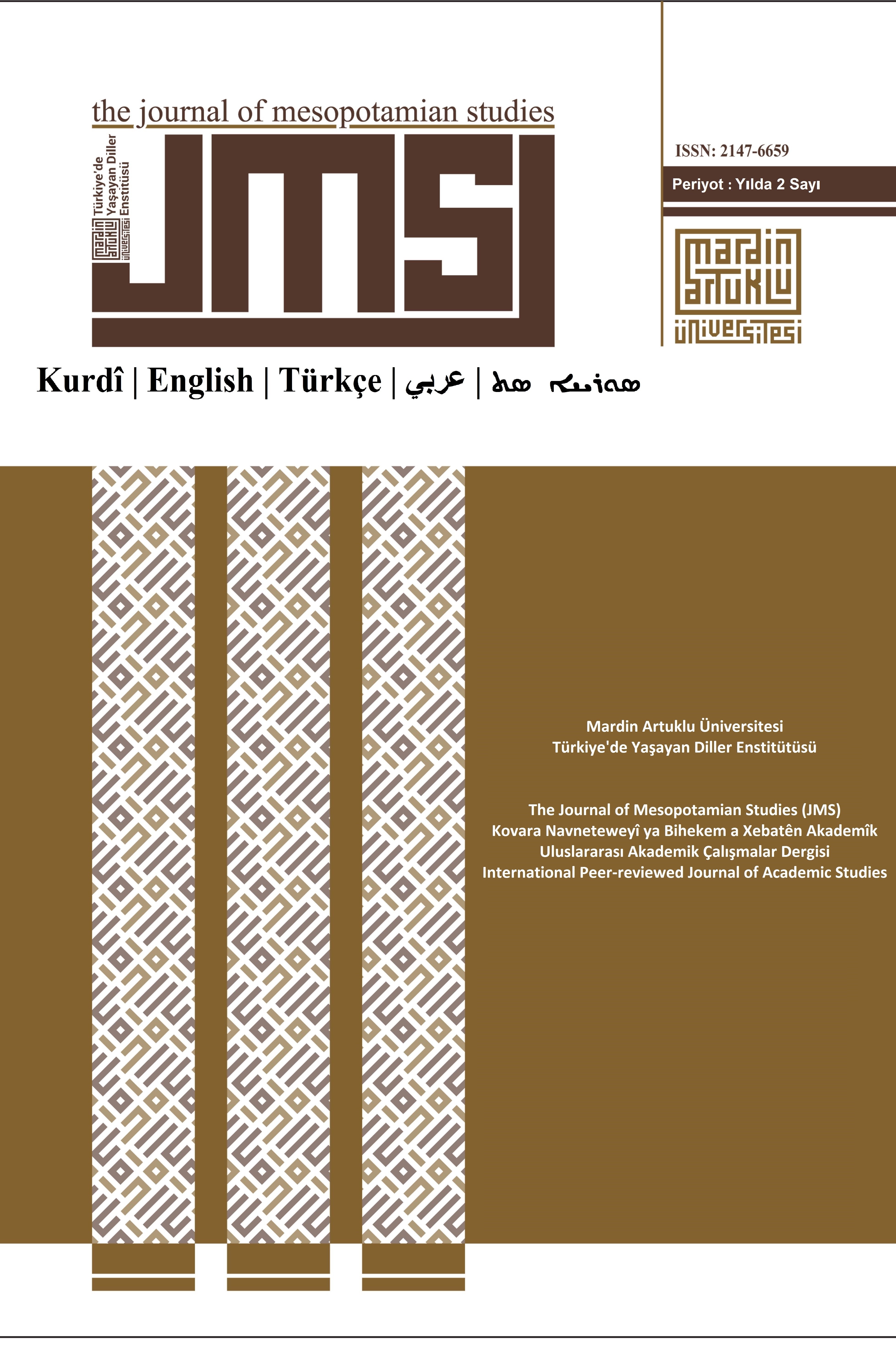Dil Statüsü ve Iraq Kürdistanında Parti Politikaları: Behdinî ve Hewrami Örnekleri
Dil Statüsü, dil politikaları, Kürtçe, Behdini, Hewrami
Language Statues and Party Politics in Kurdistan-Iraq. The Case of Badini and Hawrami Varieties
language statue, language policies, kurdish, badini, hewrami,
___
- Anonby. Erik / Sheyhohslami, Jaffer / Mohammadirad. Masud 2016. Kordestan province in the Atlas of the Languages of Iran. Paper presented at the 3th International Conference on Kurdish Linguistics. University of Amsterdam; August 25-26. 2016.
- Ferguson. Gibson. 2006. Language planning and education. Edinburgh: Edinburgh University Press.
- Garvin. Paul L. 1993. A conceptual framework for the study of language standardization. International Journal of the Sociology of Language, 100-101/1: 37-54.
- Gellner. Ernest. 1983. Nations and nationalism. Ithaca: Cornell University Press.
- Giles. Howard / Bourhis, Richard / Taylor. Donald. 1977. Towards a theory of language in ethnic group relations. In: H. Giles. ed. Language, ethnicity and intergroup relations. London: Academic Press: 307-348
- Hassanpour, Amir. 2012. The indivisibility of the nation and its linguistic divisions. International Journal of the Sociology of Language, 217: 49-73
- Kultumame. 2009. Li Zaningeha Soran Kurmanci qedexe ye.http://www.kulturname.com/?p=3434&print=1 (2011/08/01)
- KNN. 2015. April 04. Hewramîyekan bo sê serokatîyeke u hizbekan: Ta key berhest leberdem zimanekemanda [dedanên] [Hewramîmis to the three leadership and [political] parties. For how long do you want to create obstacles in front of our language). www.knnc.net/Drejey-hawaLaspx?id=43856&LinkID=4 (2016/09/05)
- Kurdistan. 2004. Constitution of the Iraqi Kurdistan Region. Unrepresented Nations and Peoples Organization. http://www.unpo.org/article/538. (2012/05/01)
- Longmanç 1998. Longman dictionary of English language and culture. Essex: Longman.
- Mackenzie. David. 2002 Gurâni. Encyclopedia İranica. Xl/4: 401-403
- Mackenzie. David N. 1962. Kurdish dialect studies l. London: Oxford University Press.
- May. Stephen. 2015. Language policy and political theory. In: D. C. Johnson / F. M. Hult. eds. Research methods in language policy and planning. A practical guide. Chichester: Wiley Blackwell: 45-55.
- May. Stephen. 2008. Language and minority rights: Ethnicity, nationalism and the politics of language. London/New York: Routledge.
- Mousazadeh, Fariborz / Faeq. Ne’man. 2016. Kalasu yoamu Horami (first grade Hawrami] Sulaimaniyah: Piramerd.
- Sheyhohslami. Jaffer. 2015. Language varieties of the Kurds. In: W Taucher / M. Vogl / P. Webinger. eds. The Kurds. History, religion, language, politics. Vienna: Austrian Federal Ministry of the Intenor: 30-51.
- Sheyholislami, Jaffer. 2012. Language policy and planning: Identity and rights in Iraqi Kurdistan. In: G. Kunsang / A. Snavely / T. Shaky. eds. Minority language in today's global society Vol. 2 New York: Trace Foundation: 106-128.
- Sheyhohslami, Jaffer / Hassanpour, Amir / Skutnabb-Kangas. Tove. eds. 2012. The Kurdish Linguistic Landscape: Vitality. Linguicide and Resistance. International Journal of the Sociology of Language, 217.
- Sheyholislami. Jaffer. 2011. Kurdish identity, discourse and new media. New York: Palgrave Macmillan.
- Sonntag, Selma K / Cardinal, L. 2015. State traditions and language regimes: A historical institutionalism approach to language policy. Acta Universitatis Sapientiae, European and Regional Studies. 8/1: 5-21.
- Tollefson, James. 2006. Critical theory in language policy. In: Thomas Ricento. ed. An introduction to language policy: Theory and method. Oxford. Blackwell: 42-59.
- White. Paul. 1991. Geographical aspects of minority language situations in Italy. In: Collin H. Williams, ed. Linguistic minorities, society, and territory. Clevedon: Multilingual Matters: 44-65.
- Wright, Sue. 2007. The right to speak one’s own language. Reflections on practice. Language Policy. 6, 323-330.
- ISSN: 2147-6659
- Yayın Aralığı: Yılda 2 Sayı
- Başlangıç: 2016
- Yayıncı: Mardin Artuklu Üniversitesi
Diyarbakır ve Mardin’deki Medreselerin Arapça’ya Olan Etkisi
Mahmoud Abdelnabi Mohamed SHOUSH
Türkçe-Arapça Dil İlişkilerine Tarihsel ve Güncel Bir Bakış: Mardin Arapçası Atasözleri Örneği
Dil Statüsü ve Iraq Kürdistanında Parti Politikaları: Behdinî ve Hewrami Örnekleri
Jaffer SHEYHOLİSLAMİ, Çevirmen: Mehmet YONAT
Anadilin Ötesinde: Bölgesel ve Yerli Bir Dil Olarak Kürtçe
Şerko Bêkes Şiirinde Kişileştirmenin Boyutları
Sovyet Kürt Romanlarında İdeoloji ve Partizanlık
Klasik Kürt (Kurmanci) Edebiyatında Mersiyeler Hakkında Bir İnceleme
